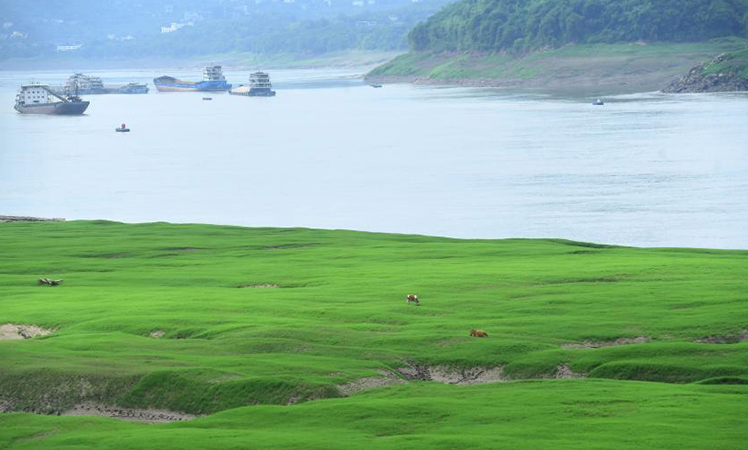Chinese companies’ overseas projects boost image of “Made in China construction”
Chinese companies’ overseas projects have not only helped to improve local infrastructure, create job opportunities for local people and cultivate a batch of professionals and technicians, but have also contributed to local economic and social development while introducing advanced Chinese technologies, equipment and construction management standards to the rest of the world, thus boosting the image of “Made in China construction.”

Photo shows the Mindanao-Visayas Interconnection Project built by China Southern Power Grid in the Philippines. (Photo courtesy of China Southern Power Grid)
Bangladesh’s Padma Bridge, which was undertaken by the China Railway Major Bridge Engineering Group Co., Ltd. (MBEC), will open to traffic in late June. It is the largest infrastructure project in Bangladesh’s history.
The mega multipurpose road-rail bridge, which crosses over the mighty Padma River to link up the northeast and southwest of Bangladesh, has been dubbed the “Dream Padma Bridge” of Bangladesh. For Bangladeshis, it is a dream that is now coming true. The opening of the bridge will end a history of crossing the riverway only by ferry or boat.
Over the course of eight years, facilities such as plants and gas stations have been rolled out on the north side of the river, contributing to a better life for local residents.
Humayon is one of the locals that has benefited from the Padma Bridge project. He now runs a fried chicken shop near the project department for the bridge in Mawa, a town on the north side of the bridge.
Humayon introduced that he had initially ran his own street stall at first. Since the start of the construction of the bridge, his business has been booming. “After the bridge opens officially to traffic, my business will get even better,” Humayon said excitedly.
The bridge will boost the circulation of goods between 21 districts in southern Bangladesh and the capital of Dhaka, providing a means to drive the country’s continued economic growth. According to calculations by relevant departments, Bangladesh’s annual GDP is projected to grow by 1.5 percent more after the bridge becomes operational, which will benefit over 80 million people. The bridge is also an important transportation hub along the Belt and Road route and a vital channel connecting the “Trans-Asian Railway.”

Vehicles run on the Nairobi expressway, which was built by the China Road and Bridge Corporation, in Nairobi, capital of Kenya. (Xinhua/Long Lei)
Besides, the Padma Bridge project has created job opportunities for locals. Wen Wusong, board chairman of MBEC, introduced that the company has generated over 50,000 job opportunities for locals since the start of the bridge’s construction.
Uzzal is one of the Bangladeshi employees working on the project. He has worked for the project for two years and has since upskilled from a newbie to become an experienced technician, which has brought a better life to his family. Uzzal’s seven-member family moved into a two-story house from a hut that was less than 40 square meters.
In addition to promoting local economic and social development, Chinese companies’ overseas projects have facilitated the export of advanced Chinese technologies, equipment and management mechanisms.
A consortium of China Southern Power Grid and another two Chinese companies signed an engineering, procurement and construction (EPC) contract to undertake the Mindanao-Visayas Interconnection Project in the Philippines. Through the project, China exported direct current transmission technology, power equipment, and construction management standards for the first time via an EPC contract.

Workers work at the track-laying construction site of the Jakarta-Bandung High-Speed Railway in Bandung, Indonesia. Several of China’s centrally-administered state-owned enterprises, including the China Railway Group Limited and Power Construction Corporation of China, have participated in the construction of the railway. (Xinhua/Xu Qin)
The 1,320 MW Payra ultra-supercritical coal-fired power plant, the largest of its kind in Bangladesh, was put into service on March 21, making it the 13th country in the world using ultra-supercritical technology, and the first country in South Asia to have full electricity coverage. It is the first power plant invested in and constructed by the China National Machinery Import & Export Corporation, a subsidiary of China General Technology (Group) Holding Co., Ltd., under a public–private partnership in Bangladesh.
China’s centrally-administered state-owned enterprises have built several new landmark buildings by applying new technologies and embracing the concept of green and low-carbon construction.
Ethiopia inaugurated on Feb. 13 a 209.15-meters-tall landmark building located in its capital city, which houses the Commercial Bank of Ethiopia (CBE). The new headquarters building project for the CBE was built by Chinese construction giant China State Construction Engineering Corporation.
Making full use of local conditions that provide a high altitude and abundant sunshine, the project’s builders installed 112 solar lights outside the building and 117 light sensors inside. The lighting system can independently control lighting levels based on the amount of sunlight and has realized an energy savings of 30 percent. Meanwhile, air-source heat pumps were applied in the project to provide hot water and a water softening system was added, further reducing energy consumption by 15 percent.
Chinese companies have also actively undertaken solar energy, wind energy and hydroelectric projects across the world, including the Upper Tamakoshi hydropower project in Nepal, the country’s largest hydropower station, injecting a new impetus into the sustainable development of the wider world.
Photos
Related Stories
- Chinese brands forge ahead toward high-quality development
- 'Made in China' cannot easily be replaced
- 'Made in China' embraces improved quality, expanded market
- High quality “Made in China” products and services shine in Argentina
- Unveil China Outside China: Redefining "Made in China"
- We went to the largest small commodity wholesale market in the world and saw the future of “Made in China.”
- China launches demonstration areas to boost Made in China 2025
- “Made-in-China” products marvel the world
- SpaceX CEO puts Twitter user who mocks "Made in China" in his place
- Euro 2016 gives a boost to 'Made in Zhejiang' products
Copyright © 2022 People's Daily Online. All Rights Reserved.









